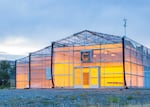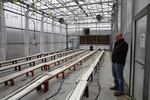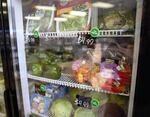
The City of John Day is hoping a new greenhouse and the fresh, local vegetables it will produce can help revitalize the town.
Courtesy City of John Day
Editor’s note: This story is part of a series looking at efforts that communities in Grant County, like other parts of rural Oregon, are taking to attempt to attract and retain workers.
The wastewater treatment plant in John Day is 72 years old, in the floodplain and failing. So city leaders plan to build a new one.
That new facility will create millions of gallons of grey water — water that is clean enough to drink once treated, but less than desirable because it comes from showers and toilets — every year. Rather than just drain that water, city leaders want to use it to improve the town and, maybe, the town’s finances.
“We could use it for agricultural irrigation,” said city manager Nick Green. “We could use it for industrial re-use, heating and cooling, landscape irrigation, and of course crop production.”
People liked the crop production idea, so back in 2019 the City of John Day used $680,000 in community development money to build a large, state-of-the-art greenhouse. The idea was to use grey water to grow fresh vegetables for local schools, grocery stores and restaurants, thus improving livability.

John Day city manager Nick Green inside the new greenhouse.
Kristian Foden-Vencil / OPB
After decades of mill closures and population loss, John Day councilors think fresh, local produce might help the town retain young families.
The greenhouse is 6,240 square feet, or about the size of two or three homes, stitched together on an old mill site.
It opened in 2020 using regular water, because the new treatment plant isn’t built yet.
But then COVID-19 struck, closing schools and restaurants — and killing demand for the city produce.
“We’re like, no, we’re pivoting again,” Green said. " That’s what start-ups do.”
The city started selling direct to homes and grocery stores.

Jason Griffin, co-owner of the Earthly Home grocery in John Day, says the fresh, local vegetables were a big hit with his customers.
Kristian Foden-Vencil / OPB
Jason Griffin owns Earthly Home, a local grocery, and he says customers love the produce. One man bought a pound of cherry tomatoes from the city greenhouse, then left.
“He came in 20 minutes or so later, tomato juice spilled all the way down his shirt and said something like: ‘Those were just like Mama’s tomatoes out of her garden. I need some more of those,’” Griffin said.
Griffin and his wife moved to John Day from Utah five years ago, to be close to family. He said fresh, healthy, locally-grown vegetables aren’t the only thing that will keep a young family like his in town, but they definitely help. He said it’s an amenity that makes residents feel they’re living somewhere other people would also enjoy.
Chris Rich, Eastern Oregon’s regional economist, thinks things like fresh veggies, a city greenhouse and a farmers market are important in making a town livable.
“They offer a connection to the community,” he said.
Young families and children have made up the biggest population loss in Grant County over the last couple of decades. Rich said they’re key to the success of a town because they add to the population, spend more and use all the amenities that make a town livable, like churches, schools and restaurants.
John Day sits in Oregon’s high desert, where the growing season is too short to farm produce on any commercial scale. So fresh veggies can be hard to find and expensive.
“Being able to have the opportunity to get our produce from a local greenhouse was huge for us,” said Shannon Adair, who owns 1188 Brewing Company on Main Street.
All her produce used to come from Boise, a three-hour drive away. She said she used to have to throw a lot away because it was rotten.

Shannon Adair, the co-owner of the 1188 brewery in John Day, said having the city build a new greenhouse to provide fresh veggies locally, was less of a risk than doing nothing, “The plan was never to create a business for the City of John Day. The plan was to start it, show it can work, and then it generates interest to do something with it. Whether it’s bring a private investor in, or whether it’s to turn it into a co-op.”
Kristian Foden-Vencil / OPB
Adair is also a member of the John Day City Council and voted to build the greenhouse. She agrees it was an unusual step for a city to take, but thinks it’s less risky than just trying the same old things — and watching her town shrink.
“The plan was never to create a business for the City of John Day. The plan was to start it, show it can work, and then it generates interest to do something with it, whether it brings a private investor in, or whether it’s to turn it into a co-op,” Adair said.
Many people here support the greenhouse idea. They’ve seen the timber harvest drop 90 percent over the last 30 years with precious little to replace it.
But there’s also a significant number of people who think it’s a waste of taxpayer money — and that the government needs to be reined in, not expanded.
People do buy the produce, but that income hasn’t covered the cost of the greenhouse yet. Whether it’s a failure or a success will likely be decided over the next year or so, as COVID-19 fades and it’s either turned into a co-op or bought by a private investor.

John Day is located in Oregon's high desert where the growing season is too short to commercially grow vegetables.
Kristian Foden-Vencil / OPB


